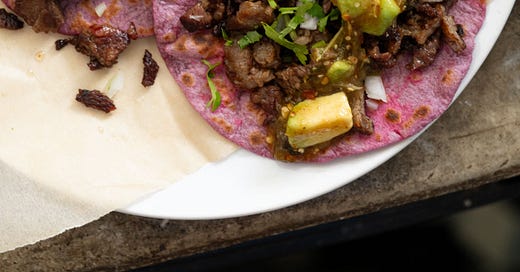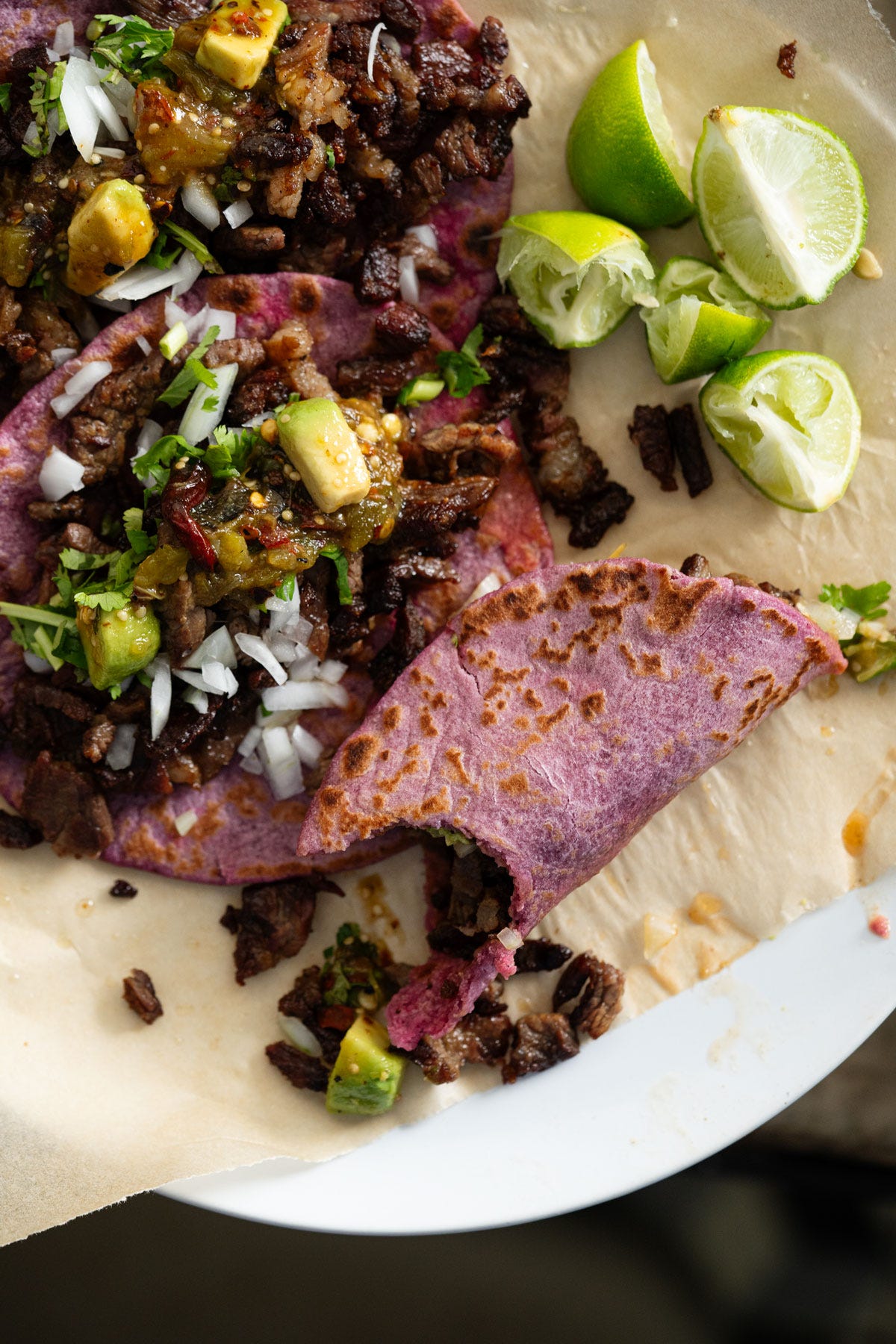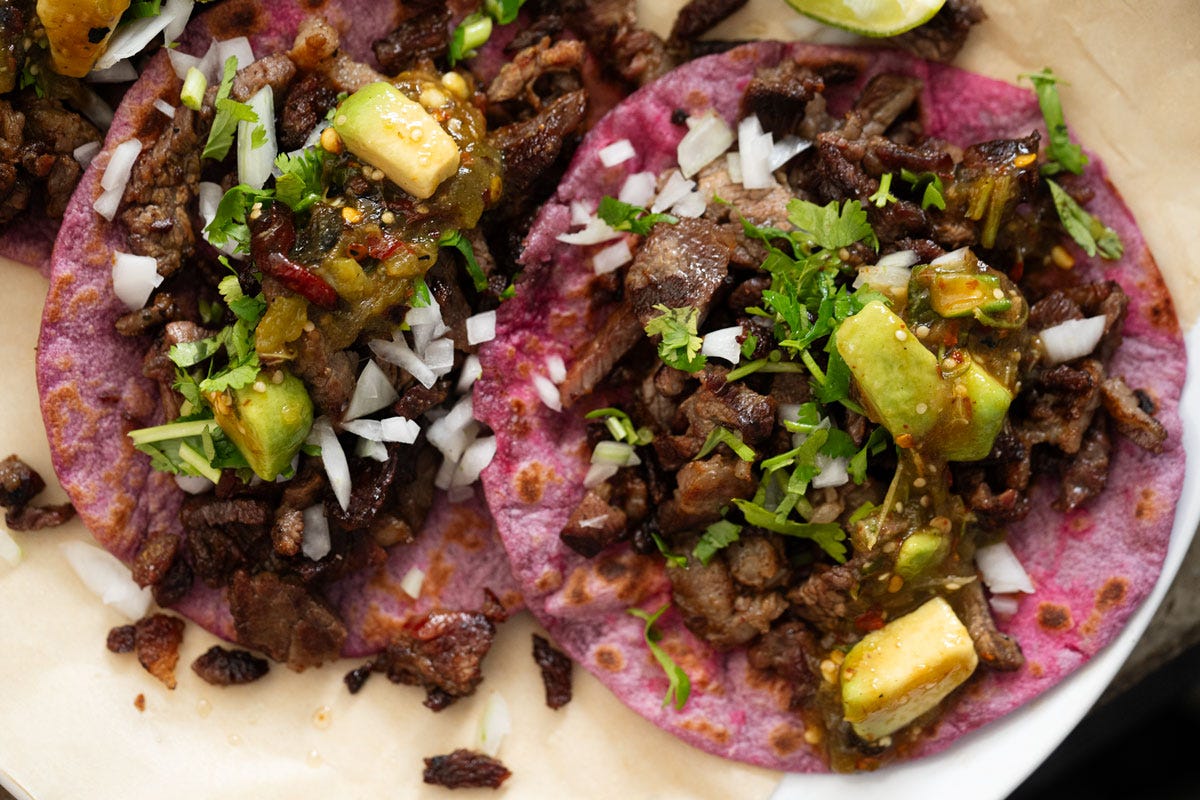Ultra pliable and soft, these purple sweet potato flour tortillas are fermented with your sourdough starter for a bonus gut friendly result.
but also– on how to increase gut bio diversity (the old fashioned way).
but first, a vip announcement: if you want a sourdough starter from me included with your yearly membership I need to know *today* (as I’m shipping them at the latest tomorrow)(you know, for weekend delivery because remember I won’t be back in the US until year end!)
what you’re getting: I’m mailing my 100+ yr sourdough starter (alive!!) to you 🌋
i.e. I’m gifting everyone US-based with a yearly subscription a little live clone of my prized starter to get you started on your sourdough adventure (they’re generally worth around $30)(and are much more valuable than a dehydrated one, as its a culture that’s been maintained for decades… and it shows).
because what you’re skipping: four to six months of daily feedings to create an “established colony”:
but what you’re asking: so Paola– is sourdough the best way to promote a healthy microbiome?
my food for thought: growing up in Mexico, but with a multicultural background, meant we often had visitors from abroad– and upon arrival, they were each provided with much needed guidance into navigating our country safely, and this included the inner workings of our food culture (for no one wanted to spend their well earned holiday in bed, prey to a pre-hispanic curse).
So one of the primordial suggestions was that upon ordering street tacos, when asked “con todo?” (i.e. with everything?)(you know: onion, cilantro and pineapple), your answer should always be a polite “no gracias”.
As it never failed to surprise our wide-eyed visitors that the prime instigators to the infamous Montezuma’s revenge were not in fact in the taco meat… but in all the raw condiments.
From different growing practices (say rich in animal compost to even using black water irrigation, often improperly treated), to lack of sanitary practices… to even just different bacteria and microorganisms than you’re used to ingesting: raw veggies (and salsas), chopped fruit, aguas frescas (and helados!)… are all the things were odds are in Montezuma’s side.
But interestingly, these are also the things which will enrich and strengthen your gut microbiome (with time)(pretty please still avoid them while traveling unless you’re trying to adjust)(and obviously avoid places with poor sanitary practices, say such as wiping knifes with dirty rags, handling money and food together, or doing dishes in a bucket of dirty water).
The thing is though, that studies are finding that food grown in rich soil and with organic practices might just be ideal not just because its void of pesticides (and arguably richer in nutrients)(at times)… but because its abundant in the microorganisms that help build the foundations of our gut flora.
But this sadly doesn’t mean that simply buying organic at your local grocery store will do the trick (and it might just break the bank), as much of the large-scale production of food leaves much to be desired (and a lot is also produced hydroponically, so it lacks that symbiotic soil-plant relationship).
because side note: across all agriculture there is one big commonality, say from the famous Harry’s Berries of California (yes, the ones that sell for $20 at Erewhon in LA) to the award winning cannabis of Fig Farms: they all clamor to the importance of working the soil properly as the key differentiator to their outstanding products.
So the best way to promote gut biodiversity is not, in fact, with sourdough– but by consuming food that’s been grown symbiotically with its environment (and then, yes, fermenting some of it to ingest even stronger cultures).
Where sourdough (and other complex carbs) come into the picture, is in providing carbs and prebiotic fiber to your gut flora in order to keep it thriving.
(and with the added bonus that the fermentation, depending how long you let it go for, will also do away with a great part of the gluten and carbs– and, vip, make nutrients more readily available)(plus the acetic acid, a bi-product of the fermentation and what makes it taste sour, also acts a lot like consuming apple cider vinegar before meals by curtailing your blood spike)(so as many of you have noted, eating things with completely fermented flour i.e. sourdough discard (my favorite being pancakes), won’t affect your blood sugar… at all) 🕵️♀️
But I’m going to stop right here for today, and instead offer you a couple simple solutions you can start today:
shop at your local farmer’s market (and inquire about their growing practices– you’ll quickly tell who’s passionate about what they do ;)!)
or search through facebook marketplace for what your neighbors are growing organically (often cheaper and a great way to support your local community)
and my personal favorite: get growing your own herbs and microgreens (yes, window sill included)(all that matters is that you’re procuring an organic soil and some fresh compost)
In fact, as we’ll talk about sooner rather than later, consuming microgreens (and arguably growing them, as having hands on contact with actual soil is prime) is one of the quickest ways to boost your health– nutrient and microbiome wise.
But today’s food in question: fermented tacos.
My home country’s pride and, quite arguably, some great food to feed your guts: with my fermented tortillas (with bonus antioxidants via the purple sweet potato to healthy fats via the lard or tallow), to a good old grass-fed carne asada, finished off with incredibly nutrient-dense toppings (that also happen to be burgeoning with microorganisms)… tacos are life might just be a statement to take literally.
(sourdough fermented) flour tortillas 🌮
ultra pliable ‘n soft
one batch makes 8 small tortillas (think taquito size) or 4 standard sized or 2 gigantic ones (say burrito style)– i.e. about 2 servings
for the tortilla dough
120g (1 cup) all purpose unbleached flour
12g (about 2 tablespoons) purple sweet potato powder (think 10% of the flour amount)
3g (1/2 teaspoon) fine sea salt
33g (2 1/2 tablespoons) lard or tallow (or 40g unsalted butter)
about 1/3-1/2 cup hot spring water
30g sourdough starter*
special equipment
a tortilla press will def make your life easier in the kitchen (in general)
wax or parchment paper
feed your starter:
**a VIP note on your starter: as long as you’re confident your starter is doubling consistently when fed, feel free to use inactive starter (i.e. yes your discard) and skip this step.
So if you’ve kept your starter in the fridge for a bit:
Add 50g of flour to feed your starter and 50g spring water (you don’t want filtered, you really do want the added minerals)(this should tell you something too about what you should be drinking too btw 👀) and mix until the dough resembles a thick pancake batter
make your dough:
Add the flour, purple sweet potato powder and salt to a large bowl and mix until thoroughly combined.
Add the lard and rub it against the flour using your fingertips until it resembles coarse bread crumbs.
Add the hot water, a little at a time and working it in with your hands until the dough just comes together. The amount will vary mainly depending on the flour you’re using and your humidity (and remember we still have to add the starter!).
Work your sourdough starter into dough and knead it on the counter until it comes together into a smooth dough (takes just a minute or two). And if your dough is too tacky feel free to add a touch more flour (conversely if it feels crumbly go for a bit more water).
Transfer to a bowl (or ziplock bag) and allow it to ferment at room temp anywhere from 3-12 hours, noting that the longer you let it go the more your culture will have worked its way through the flour (i.e. less gluten and *much* less carbs, if that’s what you’re going for).
Heat up a skillet (preferably) or pan over medium heat. You can test the heat by sprinkling a few water droplets, if the drops evaporate immediately your pan is too hot. The droplets should ‘run’ through the skillet.
Break the dough into eight balls and roll out between two sheets of parchment with a rolling pin or using a tortilla press (easier!) until the dough is ultra thin (even lightly translucent)
Cook over medium heat for just 3-6 seconds until the dough is *just* sealed on the first side (very important to get your tortillas to puff up!). Flip it over immediately (using a thin spatula or knife), and continue to cook until just lightly charred, say 30 to 40 seconds on each side. The key is not to overcook them, as they will no longer be pliable or puff up.
Keep them warm wrapped in a kitchen cloth until serving. And to rewarm, heat briefly on both sides (less than a minute).
Tortillas are best enjoyed fresh off the stove, so feel free to keep some dough handy in your fridge for up to five days (but they also freeze well ready-made for up to three months).
Provecho!
Un beso ;),
Paola
















Share this post